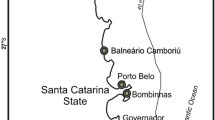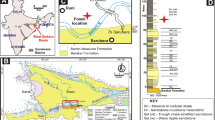Abstract
The Guri limestone Member of the Mishan Formation in the Zagros Basin consists of thick bedded limestone bearing benthic foraminifera and oyster shells. Seven species of Ostreidae and Gryphaeidae were identified as belonging to four genera (Crassostrea, Cubitostrea, Ostrea, and Hyotissa), i.e., Cubitostrea frondosa, Ostrea (Cubitostrea) dubertreti, Cubitostrea digitalina, Crassostrea gryphoides, Hyotissa virleti, Ostrea vesitata, and Ostrea plicatula. These fossils are reported for the first time from Iran. Miocene deposits in the studied area contain a rich benthic foraminiferal fauna dominated by Pseudotaberina, Meandropsina, Miogypsina, Flosculinella, Borelis, and other larger benthic foraminifera. We assign these sediments to a Burdigalian age based on Borelis melo curdica–Borelis melo melo Assemblage Zone. Paleoecological considerations also revealed that the beds were deposited in a near-shore non-agitated and shallow-water environment with moderate to low sedimentation rate. The studied oysters are located in one of more important paleogeographic settings in the world and very similar to many other Tethyan regions. The presence of these oysters suggests that the Zade Mahmud area located at margins of a sea way that connected the north and south of Zagros Basin during Burdigalian.










Similar content being viewed by others
References
Adams TD, Bourgeois F (1967) Asmari biostratigraphy: Iranian Oil Operating Companies. Geological and Exploration Division, Report, Tehran
Ala MA (1982) Chronology of Bioclastic-Corallinacean and migration of hydrocarbons in Zagros sector of southwest Iran. Am Assoc Petrol Geol Bull 66:1536–1542
Alavi M (2004) Regional stratigraphy of the Zagros fold-thrust belt of Iran and its proforeland evolution. Am J Sci 304:1–20
Aqrabawi M (1993) Oysters (Bivalvia-Pteriomorphia) of the Upper Cretaceous rocks of Jordan. Palaeontology, stratigraphy and comparision with the Upper Cretaceous oysters of Northwest Europe. Mitteilungen aus dem Geologisch Palaontologischen Institut der Universitat Hamburg 75: 1–136
Azzaroli A (1958) L’oligocene e il Miocene della Somalia: Stratigrafia, Tectonica, Paleontologica (Macroforaminiferi, Coralli, Molluschi). Pal Italica 52:1–143
Berberian M, King GCP (1981) Towards a paleogeography and tectonic evolution of Iran. Can J Earth Sci 18:210–265
Beurlen K (1944) Zur stammesgeschichte der Muscheln. Bayerischen Akademie der Wissenschaften 1–2:133–145
Beydoun ZR, Hughes Clarke MW and Stoneley R (1992) Petroleum in the Zagros basin: A Late Tertiary foreland basin overprinted onto the outer edge of a vast hydrocabon-rich Paleozoic–Mesozoic passive margin shelf. In: Macqueen RW, Leckie DA (Eds.), Foreland basins and fold belts. Am Assoc Petrol Geol Mem 55: 309–339
Bieler R, Mikkelsen PM (2006) Bivalvia-a look at the Branches. Zool J Linn Soc 148:223–235
Cox LR (1936) The gastropoda and lamellibranchia of the Green Ammonite Beds of Dorset. Q J geol Soc 92:456–471
De Serres M (1829) Geognosie des terrains Tertiaires, ou tableau dss principaux animaux invertebres des terrains marins Tertiaires, du Midi Dela Farance. A Montpellier, Paris
Deshayes GP (1824–1832) Description des coquilles fossils des environs de Paris. Mollusques 2:495–780
Douglas JA (1939) A summary of the paleontological succession in Iran and Iraq: Iranian Oil Operating Companies. Report No. 622
Eichwald E (1830) Naturhisto rische Skizze vo n Lith auen, Volh yn ien und Podolien in geognostisch- rninera logischcr: botanischer und zoologi scher Hinsicht. – Ibidem 1–256
El-Hedeny MM (2005) Taphonomy and paleoecology of the Middle Miocene oysters from Wadi Sudr. Gulf Suez Rev de Paléobio 24:719–733
Falcon NL (1974) South Iran: Zagros Mountains. In: Spencer AM (Ed) Mesozoic–Cenozoic orogenic belts-data for orogenic studies. Geolo Soc London. Special Publication. 4: 199–211
Farzinpour-Saein A, Yassaghi A, Sherkati S, Koyi H (2009) Basin evolution of the Lurestan region in the Zagros fold-and-thrust belt. Iran J Petrol Geol 32:5–19
Feldmann RM, Palubniak DS (1975) Palaeoecology of Maastricht an oyster assemblages in the Fox Hills Formation. Geol Asso Canada 13:211–233, Special Paper
Foighil DO, Taylor DJ (2000) Evolution of parental care and ovalation behaviour in oysters. Mol Phylo Evol 15:301–313
Fuchs T (1882) Beitrage zur Kenntniss der Miocaenfauna Aegyptens und derlibyschenwueste. Palaeonto 1(30):21–66
Gmelin JF (1791) Caroli a Linné Systema naturae per regna tria naturae: GE Beer, Leipzig. 13, 1(6): 3021–3910
Harzhauser M (2007) Oligocene and Aquitanian Gastropod faunas from the Sultanat of Oman and their biogeographic implications for the early western Indo-Pacific. Palaeonto (280): 75–121
Hemplton MR (1987) Construction on Arabian plate motion and extensional history of Red Sea. Tectonics 6:687–705
Heydari E (2008) Tectonics versus eustatic control on supersequences of the Zagros mountains of Iran. Tectonophy 451:56–70
Heydari E, Hassanzadeh J, Wade WJ, Ghazi AM (2003) Permian–Triassic boundary interval in the Abadeh section of Iran with implications for mass extinction: part 1-sedimentology. Palaeogeogr, Palaeoclimatol, Palaeocol 193:405–423
Hoffmann A, Pisera A, Studencki W (1978) Reconstruction of a Miocene kelp-associated macrobenthic ecosystem. Acta Geol Polon 28:377–387
Hoşgör İ (2008) Presence of Crassostrea gryphoides (Schlotheim) from the lower Middle Miocene sequence of Kahramanmaraş Basin (SE Turkey); its taxonomy, paleoecology and paleogeography. Bull Miner Res Explor Inst Turk 136:17–2
Huber H (1977) Geological map of Iran with explanatory note. National Iranian Oil Company, Exploration and Production Affairs, Tehran
Hull CE and Warman HR (1970) Asmari oil fields of Iran. In: Halbouty MT (Eds) Geology of giant petroleum fields. Am Assoc Petrol Geol Memo 14: 428–437
James GA, Wynd JG (1965) Stratigraphic nomenclature of Iranian Oil Consortium Agreement Area. Am Assoc Petrol Geol Memo 49:2182–2245
Kauffmann EG (1969) Form, function and evolution: N129- N205. In: Moore RC (ed) Treatise on invertebrate paleontology, pt. N, V. 1, Mollusca 6, Bivalvia 3. Geological Society of America, Boulder, and University of Kansas Pres, Lawrence, p 271
Lam K, Morton B (2004) The oysters of Hong Kong (Bivalvia: Ostreidae and Gryphaeidae). The Raffles Bull Zool 52(1):11–28
Laursen GV, Monibi S, Allan TL, Pickard NA, Hosseiney A, Vincent B, Hamon Y, van Buchem FSP, Moallemi A, Druillion G (2009) The Asmari Formation revisited: changed stratigraphic allocation and New Biozonation. First International Petroleum Conference and Exhibition, Shiraz
Linnaeus C (1758) Systema Naturae per regna tria naturae, secundum classes, ordines, genera, species cum characteribus, differentiis, synonymis, locis: Tomus, I editio 10, reformata. Laurentii Salvii, Holmiae, Stockholm: 824
Machalski M (1998) Oyster life positions and shell beds from the Upper Jurassic of Poland. Acta Palaeonto Polon 43(4):609–634
Mancini EA (1978) Origin of micromorph faunas in the geologic record. J Pal 52:311–322
Mayr E (1966) Anirnal species and evolution. The Belknap Press of Harvard Univ, Cambńdge, 797 pp
Mc Quillan H (1985) Fracture-controlled production from the Oligo-Miocene Asmari Formation in Gachsaran and Bibi Hakimeh Fields, southwest Iran. In: Roehl PO, Choquette PW (eds) Carbonate petroleum reservoirs. Springer, New York, pp 511–523
Newell ND (1965) Classification of the Bivalvia. Am Mus Novaitates 2206:1–25
Rafinesque CS (1815) Analyse de la nature, outableau de ĺuniverse et les corp organizes. Palermo 224
Roman F and Comm H (1940) Listes raisonnées des faunes du Pliocène et du Miocène de Syrie et du: Report, Franç. Syrie et Liban, Services Travel
Sacco F (1897) I molluschi dei terreni terziari dei Piedmonte e della Liguria. Memorie Royal Accademie Science, Torino, pp 3–24
Schlotheim EF (1813) Beitrage zur Naturgeschichte der Versteinerungen in geognotischer Hinsicht. Leonhard’s Jahrbuch für Mineralogie 7:1–100
Seeling J, Bengtson P (1999) Cenomanian oysters from the Sergipe Basin. Brazil Cret Res 20:747–765
Seilacher A (1984) Constructional morphology of bivalves: evolutionary pathways in primary versus secondary soft-bottom dwellers. J Pal 27:207–237
Seilacher A (1985) Bivalve morphology and function. In: TW Broadhead (ed.) Mollusks, Notes for a short course. University of Tennessee Studies in Geology l.3: 88_101
Seilacher A, Matyja BA and Wierzbowski A (1985) Oyster beds: morphologic response to changing substrate conditions. In: U. Bayer & A. Seilacher (eds), Sedimentary and evolutionary cycles. Lecture Notes in Earth Sciences 1:421–435
Stenzel HB (1971) Oysters: N953-N1224. In: Moore RC (ed) Treatise on invertebrate paleontology, Pt. N, V. 1, Mollusca 6, Bivalvia 3. Geological Society of America, Boulder, and University of Kansas Pres, Lawrence, p 271
Stocklin J (1968) Structural history and tectonics of Iran. A review. Am Assoc Petrol Geol 52:1229–1258
Stocklin J (1974) Possible ancient continental margins in Iran. In: Burk CA, Drake CL (eds) Geology of continental margins. Springer, New York, pp 873–887
Stocklin J and Setudehnia A (1991) Stratigraphic lexicon of Iran. Report No.18 Thrid edition
Takin M (1972) Iranian geology and continental drift in Middle East. Nature 235:147–150
Vialov OS (1936) Sur la classification des huîtres. Académie des Sciences de ÍURSS, Comptes Rendues (Doklady), New series 4/13, 1 (105): 17–20
Vredenburg EW (1928) Description of Mollusca from the post-Eocene Tertiary formations of northwestern India. Memoirs Geol Surv India 50:351–463
Yamaguchi K (1994) Shell structure and behavior related to cementation in oysters. Mar Biol 118:89–100
Acknowledgments
In this study, we are greatly indebted to Professor Magdy El-Hedeny (Alexandria University, Egypt) for identifying some specimens and important paleoecological discussions on oyster shells. We are also grateful to Dr. N. Moinzadeh (Shahid Bahonar University, Kerman) for careful and constructive review of the manuscript and Dr. M.J. Hassani for his cooperation in sample collections and preparing photographs. We are also thankful of Dr. H. Gholamalian (Hormozgan University, Bandar Abbas) and Dr. A. Bahrami (Esfahan University, Esfahan) for their critical suggestions during the study.
Author information
Authors and Affiliations
Corresponding author
Rights and permissions
About this article
Cite this article
Hosseinipour, F., Dastanpour, M. Lower Miocene oyster shells from the Southeast Zagros Basin (Zade Mahmud area, Iran) and their paleoecology. Arab J Geosci 6, 1977–1989 (2013). https://doi.org/10.1007/s12517-011-0493-2
Received:
Accepted:
Published:
Issue Date:
DOI: https://doi.org/10.1007/s12517-011-0493-2




